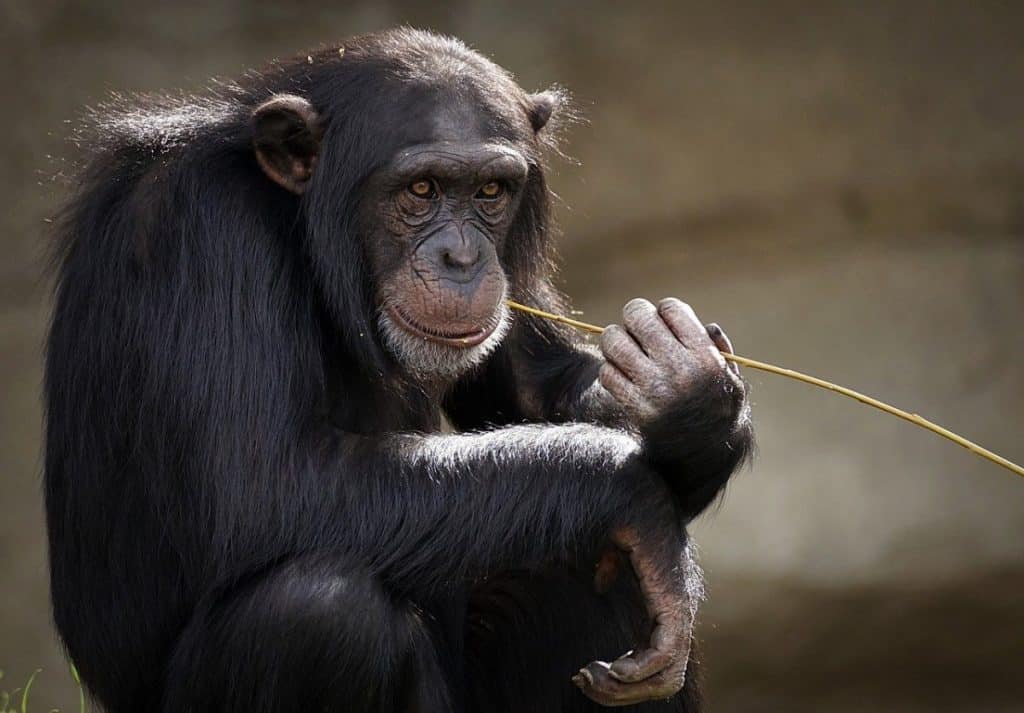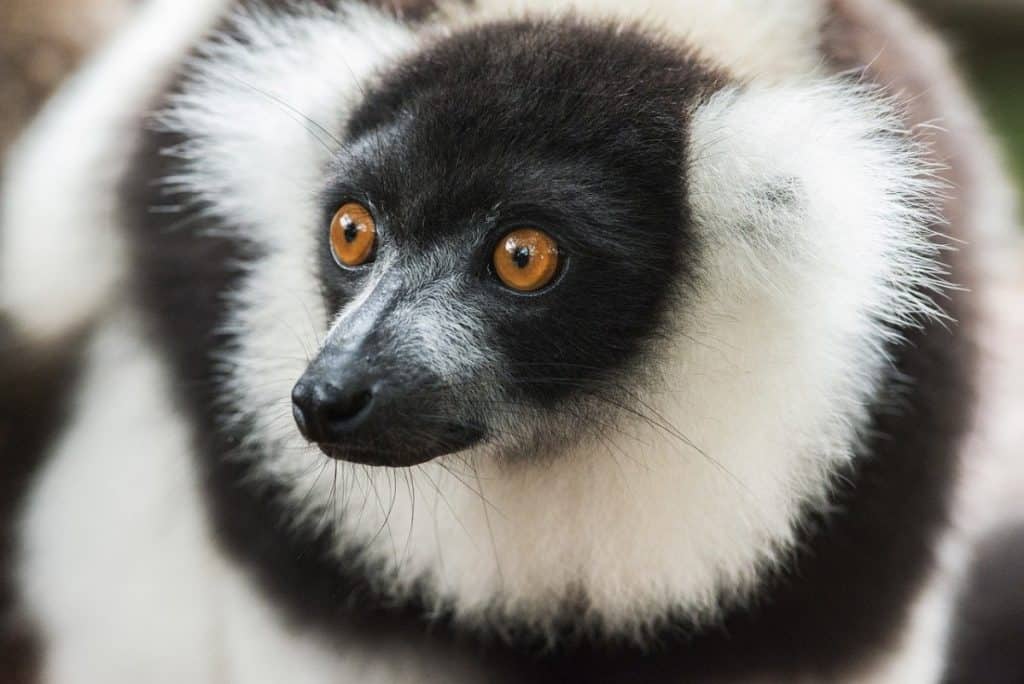There are many species of primates, and although they are very different, they all share some common characteristics. Primates can be terrestrial or arboreal, but all make good use of trees.
Primates is a taxonomic order of more than 500 mammals. Primates are made up of 2 suborders: lemurs, galagos, lorisids, tarsiers, monkeys, and apes. Primates have excellent colour vision and the ability to grasp objects, allowing them to move through trees with ease.
In this article, we look at some of the defining characteristics of primates.
Do you know how pandas reproduce? Find out here in this article I wrote

Social behaviour
Primates share many similarities with humans in their social behaviour. Many primates live in organized, hierarchical groups, with some being ruled over by one leader while other groups pass down their power to their young.
Some primates are friendly to others, while others have dedicated enemies. Some are rivals while others help each other, and some are liked while others are hated. The young grow up learning certain behaviours much as human children do, and group members communicate using sounds and gestures.
There is no single characteristic between all primates that defines them, and while not all primates are arboreal, they all show adaptations for living in the trees.
Some of the defining characteristics of primates are their brains and that they have opposable digits. They use their senses such as smell, touch, and sight and have fingernails and toenails. Although not all species possess all of these, they all show a tendency to develop them.
However, they do all have the ability to climb by grasping.
Climbing and grasping
Primates are tree-dwelling animals, and although there are many terrestrial primates, they all can grasp and climb. Man is the only primate that doesn’t essentially live in trees anymore.
Instead of digging their claws into a branch, as almost all other tree-dwelling mammals do, primates wrap their fingers and toes around them. This allows them to climb trees much faster and with more skill than any other animal.
It is thought that primates evolved from small tree shrew-type creatures, and only in the last few years have tree shrews been moved out of the primate order into the order of Scandentia.
A few million years ago, these small tree shrew animals were living in the trees, and ever since then, primates have evolved to move about in more effective ways. Evolution allowed primates to move about without risk of falling and expand their range for food quickly and with fewer predators.
Because they could grasp the branches, it allowed them to grow larger than if they used their claws to grip. This is why you will never see a chimpanzee-sized squirrel.
This was facilitated by growing long digits, which allowed them to grasp objects. Some of the oldest primates include lemurs, galagos, and lorises, classified as prosimians. These are the most primitive of the primates. These evolved about 60 million years ago and have been described as half-monkeys as they are the transitional stage between insectivores and monkeys.
For many millions of years, prosimians were the dominant mammals in trees. They could be found throughout Europe and Africa, Asia, and North and South America. There are at least 60 extinct genera of prosimian found in fossils.
Prosimians are only found in Asia and Africa, while monkeys are much more widespread. The only prosimians in Africa and Asia are nocturnal and do not compete with monkeys. Lemurs live in Madagascar, although it is not known how they got there. There are no monkeys to compete with them in Madagascar.
There are over 100 species in Madagascar, and without threat from monkeys, they can be seen during the day or at night. Some are tiny, while others are dog-sized. All lemurs share the same characteristic as other primates. They all have elongated fingers and toes capable of spreading instead of digging and wrapping them around the branches.
As primates can see in three dimensions, they can easily see their food. While other animals that rely on smell will bend over and sniff them, most primates will pick the food up to look at it. Prosimians such as lemurs could close their hands but could only move their digits all at once to grasp an object. As time progressed, monkeys, through grooming and feeding, evolved to use each finger and toe individually, allowing them to manipulate tiny objects.
This allowed them to investigate objects more thoroughly and, in doing so, remember which were good and which ones they didn’t like. This gave them a considerable advantage over prosimians as these memories required a larger brain. The increase in brain size led to better nervous systems, allowing them to control their bodies better. Although humans have larger brains than primates, this is primarily to help us speak and for better association and memories. We see, smell, hear and touch the world in almost the same way that monkeys did 25 million years ago.
Do you know what the predators of primates are? Find out in this article I wrote
Vision
Sight and smell are complementary senses, but which one is stronger depends on where the animal lives and how it uses its environment. For animals that live on the ground, smell is more critical as they can identify predators and food by smelling but not seeing them.
For an animal such as most primates, the sense of smell is less valuable, and due to this, their vision is enhanced. Primates who are arboreal can use their vision to find food among the dense, colourful foliage, and it helps them avoid falling when climbing from one tree branch to another. Primates see in colour with a large part of the brain dedicated to visual stimuli.
As the primate’s grip evolved, their senses favoured vision over their sense of smell to help this. Lemurs, a primitive prosimian, rely on smell much more than their vision. They have a less prominent snout than most insectivores, and a larger portion of their brain is dedicated to sight than is to smell. An indication of this is a primate’s small snout. While prosimians have wet noses like dogs, monkeys have dry noses.
While most primitive animals have their eyes on the sides of their heads, lemurs have them on the front of the face. While an animal with eyes on the side of their heads can see without turning their heads, they can not judge distance well. This would be disastrous for an animal that spends most of its time high up in the trees jumping from branch to branch. A lemur’s eyes are on the front of their faces, and as their vision overlaps, this gives them a good sense of depth.
The hairs around the hands and feet enhance a primate’s sense of touch. Whereas an animal that relies on its sense of smell will walk with its head down, primates hold their heads up to use their excellent vision fully. A primate’s skull reflects this as the orbital bones direct forwards and are walled in to protect them on all sides.

Movement
When we think of monkeys, we often think of them jumping from branch to branch or walking on top of them before jumping to another. While monkeys generally walk on all fours, it is apes that can swing from branch to branch.
How a primate moves is related to the evolution of their digits and their ability to grab branches. Their movement allows them to escape from their enemies and reach food. Most lemurs move on all fours through the trees, using their elongated digits to grasp onto the branches. Galagos or bushbabies can make leaps of a few meters to move around and to get away from predators. Neither of these movements would be possible if they didn’t evolve long digits.
While bushbabies are quick, other arboreal primates are much slower. Lorises and pottos move deliberately along branches, either on top or hanging underneath, alternating their hands and feet forward. Lorises can often be seen hanging by their feet, supporting the weight of their bodies before pulling themselves up using only their leg muscles.
As with bushbabies, tarsiers also jump to get around. Tarsiers are the second smallest primate with short arms but long, powerful legs. They also have an excellent sense of vision with large eyes, relying on image over smell, as seen by their short snout. Unlike all other primates, tarsiers are the only carnivorous primates. Tarsiers are primates but are not monkeys, and it is thought that monkeys evolved from an animal more primitive than the tarsier.
Monkeys are quadruped, and their arms and legs are placed to restrict their movement to using them forwards and backwards. Monkeys walk very much like most other four-legged animals, even when in trees, running along the tops of the trees.
However, apes are different as their bodies are built for other movements. Apes such as gorillas and orangutans have long arms that can reach out in all directions. This allows them to swing from tree to tree and is what you think of when you see a primate in a tree.
Apes are still quadrupeds; however, they can move differently than monkeys do. Chimpanzees and gorillas walk on all fours, but they walk on their knuckles, unlike monkeys. Gibbons can be seen walking on two legs with their arms held high for balance. Orangutans are rarely seen on the ground. The only primate that can walk upright is man, which is due to the structure of our pelvis and legs.
To remember the difference when looking at a primate, apes will swing through the trees while monkeys run across or under branches.
Due to their size, apes swing under trees as high branches would be too thin to support their weight running across them. By swinging underneath them, their weight can be divided over several branches, allowing them to feed easier and from branches, they would not usually get to.
Size
Apes, apart from gibbons, are larger than monkeys. Their size gave them an advantage over monkeys as smaller animals are hunted by predators more easily. Being larger also gave them a much longer life span. Gorillas can live for up to 40 years, while a lemur will live only half of that time. A large animal has a slower metabolism than smaller animals, and their internal organs, which are not working as hard, do not wear out as quickly.
There are many differences between gorillas and chimpanzees. You can find them here.

